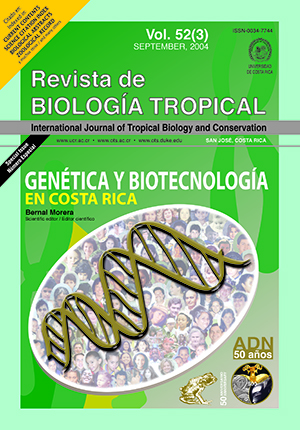Abstract
The coffee berry borer Hypothenemus hampei Ferrari (Coleoptera: Scolytidae) was first reported infecting Costa Rican coffee plantations in the year 2000. Due to the impact that this plague has in the economy of the country, we were interested in seeking new alternatives for the biological control of H. hampei, based on the entomopathogenic bacteria Bacillus thuringiensis. Atotal of 202 B. thuringiensis isolates obtained from Costa Rican coffee plantations infested with H. hampei were analyzed through crystal morphology of the crystal inclusions and SDS-PAGE of d-endotoxins, while 105 strains were further evaluated by PCR for the presence cry, cyt and vip genes. Most of the Bt strains showed diverse crystal morphologies: pleomorphic (35%), oval (37%), bipyramidal (3%), bipyramidal and oval (12%), bipyramidal, oval and pleomorphic (10%) and bipyramidal, oval and cubic (3%). The SDS-PAGE analyses of the crystal preparations showed five strains with d-endotoxin from 20 to 40 kDa, six from 40 to 50 kDa, seven from 50 to 60 kDa, 19 from 60 to 70 kDa, 29 from 70 to 100 kDa and 39 from 100-145 kDa. PCR analyses demonstrated that the collection showed diverse cry genes profiles having several genes per strain: 78 strains contained the vip3 gene, 82 the cry2 gene, 45 the cry1 and 29 strains harbored cry3-cry7 genes. Atotal of 13 strains did not amplified with any of the cry primers used: cry1, cry2, cry3-7, cry5, cry11, cry12 and cry14. Forty-three different genetic profiles were found, mainly due to the combination of cry1A genes with other cry and vip genes. The genetic characterization of the collection provides opportunities for the selection of strains to be tested in bioassays against H. hampei and other insect pests of agricultural importance.References
Apoyolo, C.I., L. Drif, J.M.Vassal, H. Debarjac, J.P. Bossy, F. Leclant & R. Frutos. 1995. Isolation of multiple subspecies of Bacillus thuringiensis from a population of the European sunflower moth, Homoeosoma nebulella. Appl. Environ. Microbiol. 61: 4343-4347.
Arrieta, G. 2003. Caracterización molecular de las d-endotoxinas de una colección de Bacillus thuringiensis aislada a partir de ecosistemas silvestres y agrícolas de Costa Rica. Tesis de Maestría, Universidad de Costa Rica, San José, Costa Rica. 110 p.
Bechtel, D. B. & L.A. Bulla. 1976. Electron microscopic study of sporulation and parasporal formation in Bacillus thuringiensis. J. Bacteriol. 127: 1472-1481.
Ben-Dov, E., A. Zaritsky, E. Dahan, Z. Barak, R. Sinai, R. Manasherob, A. Khamraev, E. Troitskaya, A. Dubitsky, N. Berezina & Y. Margalith. 1997. Extended screening by PCR for seven cry-group genes from field-collected strains of Bacillus thuringiensis. Appl. Environ. Microbiol. 63: 4883-4890.
Bernhard, K. 1986. Studies on the delta-endotoxin of Bacillus thuringiensis var. Tenebrionis. FEMS Microbiol. Lett. 33: 261-265.
Bernhard, K., Jarret P., M. Meadows, J. Butt, D.J. Ellis, G.M. Roberts, S. Pauli, P. Rogers & H.D. Burges. 1997. Natural isolates of Bacillus thuringiensis: worldwide distribution, characterization and activity against insect pest. J. Invertebr. Pathol. 70: 59-68.
Brun, L.O., C. Marcillaud, V. Gaudichon & D.M. Suckling. 1989. Endosulfan resistance in Hypothenemus hampei (Coleoptera: Scolytidae) in New Caledonia. J. Econ. Entomol. 82: 1312-1316.
Bravo, A., S. Sarabia, L. López, H. Ontiveros, C. Abarca, A. Ortiz, M. Ortiz, L. Lina, J. Villalobos, G. Peña, V. Noez, M. Soberón & R. Quintero. 1998. Characterization of cry genes in a Mexican Bacillus thuringiensis strain collection. Appl. Environ. Microbiol. 64: 4965- 4972.
Carozzi, N. B., V.C. Kramer, G. W. Warren, S. Evola & M.G. Koziel. 1991. Prediction of insecticidal activity of Bacillus thuringiensis strains by polymerase chain reaction product profiles. Appl. Environ. Microbiol. 57: 3057-3061.
Chen W. & T. Kuo. 1993. A simple and rapid method for the preparation of gram-negative bacterial genomic DNA. Nucleic Acid Research 21: 2260.
Estruch, J.J., G.W. Warren, M.A. Mullins, G.J. Nye, J.A. Craig & M.G. Koziel. 1996. Vip3A, a novel Bacillus thuringiensis vegetative insecticidal protein with a wide spectum of activities against lepidopteran insects. Proc. Natl. Acad. Sci. 93: 5389-5394.
Ferrandis, M. D., V. M. Juárez-Pérez, R. Frutos, Y. Bel & J. Ferré. 1999. Distribution of cry1, cryII and cryV genes within Bacillus thuringiensis isolates from Spain. Syst. Appl. Microbiol. 22: 179-185.
Gustafson, M.E., R.A. Clayton, P.B. Lavrik, G.V. Jonhson, R.M. Leimgruber, S.R. Sims & D.E. Bartnicki. 1997. Large-scale production and characterization of Bacillus thuringiensis subsp. tenebrionis insecticidal protein from Escherichia coli. Appl. Microbiol. Biotech. 47: 255-261.
Hatanaka, T., Y. Choi, T. Kusano & H. Sano. 1999. Transgenic plants of coffee Coffea arabica from embryogenic callus via Agrobacterium tumefaciens-mediated transformation. Plant Cell Reports 19: 106-110.
Kim, H.S., D.W. Lee, S.D. Woo, Y.M. Yu & S.K. Kang. 1998. Distribution, serological identification, and PCR analysis of Bacillus thuringiensis isolated from soils of Korea. Curr. Microbiol. 37: 195-20.
Le Pelley, R.H. 1968. Pest of coffee. London, Longman. 590 p.
Méndez-López, I., R. Basurto-Ríos & J. Ibarra. 2003. Bacillus thuringiensis serovar israelensis is highly toxic to the coffee berry borer, Hypothenemus hampei Ferr. (Coleoptera: Scolytidae). FEMS Microbiol. Lett. 11131: 1-5.
Porcar, M. & V. Juárez-Pérez. 2003. PCR-based identification of Bacillus thuringiensis pesticidal crystal genes. FEMS Microbiol. Rev. 26: 419-432.
Samsonov, P., R.I. Padrón, C. Pardo, J. Cabrera & G.A. De al Riva. 1997. Bacillus thuringiensis from biodiversity to biotechnology. J. Ind. Microbiol. Biotech. 19: 202-219.
Sanchis, V., D. Lereclus, G. Menou, J. Chaufaux & M.M. Lecadet. 1988. Multiplicity of d-endotoxin genes with different specificities in Bacillus thuringiensis aizawai. Mol. Microbiol. 2: 393-404.
Schnepf, H.E., N. Crickmore, N. Van Rie, J. Dereclus, J. Baum, J. Feitelson, D.R. Zeigler & D.H. Dean. 1998. Bacillus thuringiensis and its pesticidal crystal proteins. Microbiol. Mol. Biol. Rev. 62: 775-806.
Travers, R. S., P.A.W. Martin & C.F. Reichelderfer. 1987. Selective process for efficient isolation of soil Bacillus spp. Appl. Environ. Microbiol. 53: 1263-1266.
##plugins.facebook.comentarios##

This work is licensed under a Creative Commons Attribution 4.0 International License.
Copyright (c) 2004 Revista de Biología Tropical


